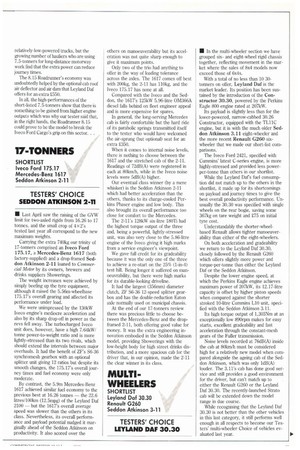17-TONNERS
Page 33

If you've noticed an error in this article please click here to report it so we can fix it.
SHORTLIST Iveco Ford 175.17 Mercedes-Benz 1617 Seddon Atkinson 2-11
TESTERS' CHOICE SEDDON ATKINSON 2-11
• Last April saw the raising of the GVW limit for two-axled rigids from 16.26 to 17 tonnes. and the small crop of 4x2's tested last year all correspond to the new maximum weights.
Carrying the extra 740kg our trinity of 17-tanners comprised an Iveco Ford 175.17, a Mercedes-Benz 1617 (both factory-supplied) and a drop-framed Seddon Atkinson 2-11 loaned to Commercial Motor by its owners, brewers and drinks suppliers Showerings.
The weight increases were achieved by simply beefing up the tyre equipment, although it raised the 5.56m-wheelbase 175.17's overall gearing and affected its performance under load.
We were unimpressed by the 130kVer Iveco engine's mediocre acceleration and also by its sharp drop-off in power as the revs fell away. The turbocharged Iveco unit does, however, have a high 7.64kW/ tonne power-to-weight ratio and is more lightly-stressed than its two rivals, which should extend the intervals between major overhauls. It had the benefit of ZF's S6-36 synchromesh gearbox with an optional splitter unit giving 12 ratios but despite its smooth changes, the 175.17's overall journey times and fuel economy were only moderate.
By contrast, the 5.9m Mercedes-Benz 1617 achieved similar fuel economy to the previous best at 16.26 tonnes — the 22.6 litres/100km (12.5mpg) of the Leyland Daf 2100 but the 1617's overall average speed was slower than the others in its class. Nevertheless, its overall performance and payload potential nudged it marginally ahead of the Seddon Atkinson on productivity. It also scored over the others on manoeuverability but its acceleration was not quite sharp enough to give it maximum points.
Only two of the trio had anything to offer in the way of loading tolerance across the axles. The 1617 comes off best with 200kg, the 2-11 has 110kg, and the Iveco 175.17 has none at all.
Compared with the Iveco and the Seddon, the 1617's 125kW 5.96-litre 0M366A diesel falls behind on fleet engineer appeal and is more expensive for spares.
In general, the long-serving Mercedes cab is fairly comfortable but the hard ride of its parabolic springs transmitted itself to the tester who would have welcomed the air-sprung (but optional) seat for an extra 250, When it comes to internal noise levels, there is nothing to choose between the 1617 and the stretched cab of the 2-11. Readings of 72dB(A) were registered in each at 80kmih, while in the Iveco noise levels were 5dB(A) higher.
Our eventual class winner (by a mere whisker) is the Seddon Atkinson 2-11 which had better acceleration than the others, thanks to its charge-cooled Perkins Phaser engine and low body. This also brought its overall performance too close for comfort to the Mercedes.
The 2-11's 128kW six-litre 180Ti had the highest torque output of the three and, being a powerful, lightly-stressed unit, was also very close to the 5.86-litre engine of the [Yee° giving it high marks from a service engineer's viewpoint.
We gave full credit for its gradeability because it was the only one of the three to achieve a re-start on the 25% (1-in-4) test hill. Being longer it suffered on manoeuvrability, but there were high marks for its durable-looking driveline.
It had the largest (356mm) diameter
clutch, 56-36 12-speed splitter gearbox and has the double-reduction Eaton axle normally used on municipal chassis.
At the end of our 17-tonners review there was precious little to choose between the Mercedes-Benz and the dropframed 2-11, both offering good value for money. It was the extra engineering innovation embodied in the Seddon Atkinson model, providing Showerings with the low-height body for high street drinks distribution, and a more spacious cab for the driver that, in our opinion, made the 2-11 the clear winner in its class.
































































































